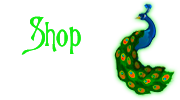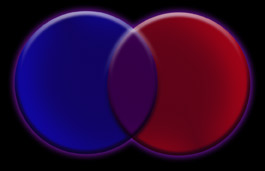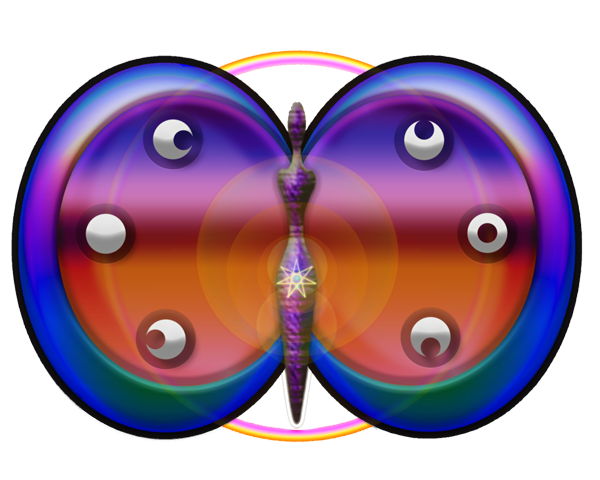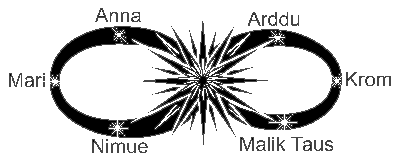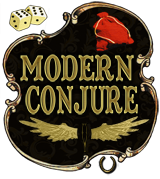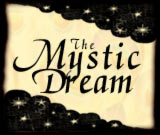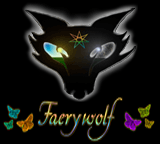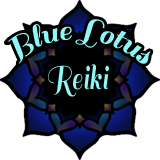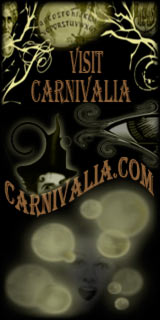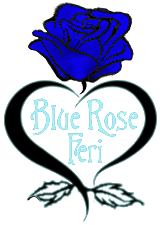 |
|||||||
 In the Bloodrose-derived lines of the F(a)eri(e)1 tradition, in which I was initially trained, there is in use a major theological icon that attempts to capture the endless essence of our cosmology. When considering the eternal nature of Divinity, the lemniscate (commonly referred to as the infinity symbol) represents the constant and morphing flow of energy as it emanates from the central point; what we know as the Star Goddess; that primal point of all creation. Flowing first to the bottom left and moving upward, we can see this power take on the traditional feminine forms of maiden, mother, and crone before flowing back and down through the center. Continuing to the right, this power embodies the masculine youth, father, and sage, only to continue this journey ad infinitum. These stations on our symbol (as seen in the image above) are represented at first by lunar glyphs to represent the Goddess: a waxing crescent, a full moon disk, and a waning crescent. Solar imagery is then employed to represent the God by way of rising sun, sun-at-zenith, and setting sun. Thus both a monthly and daily cycle are represented by way of the lemniscate.
This cosmology can also be symbolically visualized in terms of the vesica pisces, which consists of two circles intersecting so that they overlap each other. The central almond shape that results from this overlap has sometimes been described as the yoni or womb of the Great Goddess, and so is equal (at least in terms of theological definition) to our lemniscate's central point. "Holy Mother,
In You we live, move, and have our being. From You all things emerge… And unto You all things return." 2 When considering one of the many creation myths that are present in the Feri tradition we can see certain parallels with our lemniscate model. According to Starhawk, after the Goddess makes love with Her own reflection, the image before Her moves outward, becoming more masculine along the way, becoming the Blue God, the Green One, and finally the Horned God. 3 Here we see the mutable nature of Divinity and when taken in conjunction with the poetic teaching of the prayer above, we can begin to see this model in action. The Star Goddess (also referred to as God Herself) is the ultimate Deity, She-who-emerges-from-nothingness, as well as She-who-cannot-be-(at least fully)-understood. She (who is also He) is that single unifying point within the great Void in which time and space are meaningless. This is the great womb of the Goddess, pregnant with all possibility. Like the mathematical singularity, the laws of physics do not apply here and so there are no limitations, making this the most magickal (and potential) place in the universe. We see this point as being the central point of the infinity symbol; it is that moment before creation occurs in which all choices are equally valid. Only when this power moves outward from the Goddess of All Potential do we see limitations being created and adhered to. It is these limitations that allow form to arise and cause the natural laws of the Universe to function. Seasonal Manifestations One way to see these forms is to witness them in the cycles of nature. Our lemniscate illustrates the seasonal changes along its serpentine pathway, demonstrating an entire lifecycle on each of its two lobes. When the Goddess sees Her reflection it is first as Nimüe, the young maiden, who then grows and becomes Mari, the mother, and finally as Anna, or Anysa, the aged crone, before returning back to the center. In these three major points of definition we can easily see the seasonal cycles played out. Maiden Nimüe can represent the spring, especially the new growth of both plants and animals. Her emblem is that of a 6-day old crescent moon, connecting this sphere of our model with predominately lunar symbolism. She is the wild spirit of youth and potency; the arouser of life; the embodiment of the Black Heart of Innocence. A crescent moon rests on her brow as primal snakes writhe in her hair. Childlike exuberance exudes from her toothy grin, but watch out! For all of her playfulness there is also something disturbing about her... a danger and even a sexuality that is not comfortable when witnessed in a creature so young. The influence of Nimüe can be easily felt at this time of year and through the summer solstice, at which time She plays an important role in the working mythos of the Feri sabbat. Mother Also at this time the presence of the goddess Mari is strongly felt. She is the spirit of the earth, sky, and sea, and is that aspect of the Goddess that even casual practitioners of the modern Craft are most familiar with. She wears a crown of a dozen stars, Her black hair veiling her shining silver body as she stands upon the ocean. Because She is archetypically the height of strength and power, She is associated (however marginally) with the height of summer, but also with the slow decline of autumn, not because Her powers are fading, but because She represents the ultimate harvest, for She carries within her fully-pregnant womb the Divine Child, who shall be born when this cycle is repeated next spring. The full moon is her emblem, continuing the lunar symbolism. Crone The final station that we encounter upon this lobe of our glyph is that of Anna, the hag, who is the dread power of winter and of death. It is She who has accumulated the wisdom of the forbidden knowledge of Witchcraft (and indeed one of her titles, "Black Anna of the Forbidden Mysteries" leaves little room for debate on this matter) as well as direct knowledge of death and of healing. She wears a crown of nine stars 4 and is sometimes accompanied by a raven or vulture, which is also Her emblem. The lunar symbolism continues with her traditional garb in that she holds a silver sickle, the crescent-shaped scythe that resembles the form of a waning moon. Youth With the cycles representing the Divine Feminine now complete, we can follow the progression of the Star Goddess' power once more as She manifests this time in masculine form. Again we can see the power manifest in the cycles of spring, this time as the young Blue God, also called the Dian y Glas. 5 Traditionally the Blue God is said to appear as an androgynous youth with an erect phallus and the breasts of a young girl, though he does not appear to me in that guise. To me his "androgyny" is expressed solely in his softness, and indeed at times he appears to me naked and swathed in lavender silks, smiling and dancing seductively amongst the stars. In some teachings He is said to represent our own personal Divinity; our "Higher Selves" to which we pray in order to hasten our own evolution. We are reminded by His iconography that the power that manifests as spirituality is sexual in nature: a serpent coils around His neck, and in fact one of His titles is "the serpent in the well", who is seen rising in the springtime, an obvious phallic reference and may also represent what some practitioners of Tantric mysticism know as kundalini energy. Peacock feathers adorn His hair connecting Him to Melek Ta'us, the Peacock Angel of the Yezidis who, despite outsiders misrepresenting Him as "the devil", regard Him as the true God of this world. Father/Lover As we continue to move on our model and into the furthest point outward, we encounter the Horned God, Krom, sometimes called the Harvest Lord. He is the perfect twin of the Goddess Mari, and in Him the solar associations are quite evident. His emblem is the golden sun and he is the power of its peak in summer. He sometimes appears as a strong stag-headed man with shining golden skin, His neck adorned with spring and summer flowers. He is naked and appears with an erect phallus and so His powers of sexuality and virility are quite evident in themselves. He is at once both "lover" and "father" depending on what it is that we need from Him at the time, regardless of what we may feel that it is that we need. He is the most blatantly masculine of the Infinitum 6, and like his female counterpart is most likely to be recognized as the archetypal God of Witchcraft. Sage/Teacher/Guardian Moving still through our cycles of the seasons we can see a subtle shift as we approach autumn. Our beloved Horned God, once the epitome of strength and virility, begins his slow decline as the sun makes its journey into the dark half of the year. Reaching winter, our God is now the dread God of death, the Arddu 7, or "Royal Darkness". Another Horned God figure, He is usually depicted with the black wings of a bat, red eyes, a single red jewel upon his forehead, and a flaming torch between his horns. Traditionally he has the head of a goat, and the breasts of an old woman, but He has never appeared to me in that guise. I almost consistently see Him with the head of a bull; a symbol that I feel better reflects His mighty power and primal nature. His sexuality is at once more internalized than his previous counterparts, while at the same time still most definitely present. He is the Guardian of the Crossroads, and because He brings the knowledge and wisdom of death, is the great teacher. His emblem is the skull and crossbones for reasons that should need little elaboration. All who would pass through the dread gate must first confront Him. He can represent our own fears, and the ecstasy that we can experience when we face them… and in ecstasy we return once more to our central point, having traversed completely the cycles of the lemniscate, returning to the Goddess; to God Herself. "And to You all things return…"
All Gods are Feri Gods… While it is true that most often these particular deities8 seem to align themselves to this glyph in Feri almost exclusively, it is precisely the symbol's inclusive nature that makes it so appealing. In Bloodrosian9 Feri it is taught that it is not simply these particular seven deities that find their home on our beloved symbol, but in fact all deities.10 According to Willow Moon, a Feri initiate and teacher in the NightHares line, the trinities on each side of our lemniscate represent points of convenience in which we are more easily able to see the fullest characteristics of the aspects of Deity.11 With this in mind it becomes quite a useful tool when considering the nature of God(dess)hood. Deities such as Hecate or Brighid can be placed upon the paths of the symbol in order to reflect upon certain of their qualities. As we have seen, however, the nature of Divinity is mutable and so we do not place these beings upon this model in order to "pin them down", so to speak, but instead to attempt to grasp their essence just a little bit more than we have previously. Tools of Circumstance When used as a tool for the talker it may prove useful to be able to examine the attributes of the Gods from an intellectual perspective, comparing and contrasting them and seeing how they might fit in with each other in an overall cosmology. For instance, we can see from our model how Nimüe, and how Persephone, for example, might compare to each other, noticing how they both have strong associations with innocence, and with the spring. We must keep in mind, however, that just as we place a God on one station, so this Deity may also appear on another. Both are equally true; another example of how Feri seems to revel in the paradoxical. For example, many Feries with whom I have spoken with share an intuitive understanding of a particular Deity that we can cite in our exploration of this intellectual model. When considering the Blue God in His forms of Dian y Glas and of Melek Ta'us we can see how they share many qualities and attributes. But often the young Dian y Glas is differentiated from Melek Ta'us in such a way that we may feel confident placing the latter in a space in between the spring and summer stations on our model. Melek Ta'us appears to me in an older, somewhat darker, more severe form. His sexuality is still present, but does not express itself in nearly as soft a manner as does his more youthful counterpart. So where we were once able to see just one God, we can now distinguish specific aspects within the larger Deity-spectrum, like individual bands of colored light differentiated by a prism. Now we are able to perceive the larger "Divinity complex"12 , knowing that while separate beings in their own right, they are also a part of a larger holism. When used as a tool for the fetch, we can meditate upon the motions and changing nature of Deity, letting go of our rational assumptions that would seek to define things in either/or classifications. What may be a helpful way to approach a thing at one time may prove to be a hindrance under different circumstances. Conflict and Clarity Much confusion has been wrought over the use of this symbolic teaching in Feri, the majority of which centers upon the use of other cosmologies which, on the surface, appear to be contradictory. While the lemniscate model appears to describe Deity in terms of two trinities of each sex emerging from the Star Goddess, the cosmology espoused by the late Victor Anderson reflects that of a triple Goddess and a duel God. If we are forced to think only in literal terms, then we are immediately confronted with what appears to be a serious divergence from traditional material. If the teachings of Victor are assumed to represent a "core mythology" of the Feri tradition13 , then this newer model is seemingly incorrect. It has been argued that the lemniscate is not truly a part of the Feri tradition precisely because of this divergence, pointing out that the mythology of the God in triple form is the result of forcing an overlaying model over traditional mythos. But a deeper look at both cosmologies reveals their underlying equivalence. Of great importance to both models is the idea of the Goddess and Her two consorts, known in Feri as the Divine Twins. It is said that the Goddess took two bright spirits into Her womb and perfected them into God.14 They are both Her divine son and lover. According to Cora Anderson, though they both "are male in function they are like all Gods, both male and female in one." She goes on to illustrate how they can pair themselves in either opposite or same-sex relationships, both sexually active and not.15 This is of tremendous importance because it gives us a much needed insight into the nature of the Twins. It is not difficult to now perceive our lemniscate model with new eyes and see each lobe as a possible manifestation of one of the Twins, each one circling the Star Goddess out of love. With this in mind we can begin to understand the mutable nature of Feri even deeper; for even this seemingly all-inclusive model now reveals its own limitations, useful though it may be. An alternate but similar model might describe the Twins as both being either male or female. It is really a minor detail when taken in consideration the sheer vastness of the Infinitum. Another important insight in the nature of the Twins comes from the teachings of Victor and Cora Anderson which state, "Either one or both of the Divine Twins can fulfill the function separately or together like two candle flames blended into one."16 This opens up whole new possibilities, enabling the practitioner a deeper perspective on not just the Twins, but of what we have previously thought of as the individual Gods. Not only are the Twins seen to manifest separately on each lobe of our model, but the individual Gods themselves are understood to have Twin aspects as well. For example, the Blue God can be seen as both Dian y Glas, but also as Melek Ta'us, among other combinations. Krom has other aspects that include what has come to be called the Red Man and the Green Man, who are the forces of animal life and vegetable life, respectively. These manifestations of the Divine Twins are sometimes seen as being lovers, but not exclusively so. Mari too has similarly colored aspects denoting specific attributes and powers. These symbolic understandings do not exist in conflict with our other models, but in harmony with them. Krom might be Twins in Himself, but individually He is also the Twin to Mari, who exists opposite him on our cosmological glyph. One perspective need not be wrong for another to also be correct.
As long as Feri is being practiced then there will continue to be innovations, creations, and evolutions. Exercises, myths, and even Deities are all being constantly revealed to us in new and different ways. When we connect to the Power, and to the Star Goddess, we are inviting Her to move through us, changing us forever. It is only to be expected that She will manifest in new ways as She is mediated into the world by Her priest/esses. New models will arise to reveal their usefulness, allowing us an opportunity to try and experience Deity in new ways. When we are able to look beyond the present forms to perceive the truths that lay beyond them, then we are well on our way toward wisdom. ©2005 Storm Faerywolf
ENDNOTES: 1. I sometimes use this spelling in order to both illustrate the mutable nature of our tradition, as well as to attempt to include those lines that were formed before Victor Anderson began using the spelling "Feri", sometime in the 1990's. Being, for the most part, an oral tradition, there is no "correct" spelling, a further testament to the individual nature of our religion. 2. Traditional Feri prayer based upon the Cretica by the poet and seer Epimenides of Knossos (6th century BCE) in which he addresses the God Zeus: "They fashioned a tomb for thee, O holy and high one- (See http://en.wikipedia.org/wiki/Epimenides) Later this would be quoted by Paul and make it's way into a passage in the Bible, "For in him we live, and move, and have our being; as certain also of your own poets have said, For we are also his offspring.", Acts 17:28, King James Version. 3. Starhawk, The Spiral Dance: A Rebirth of the Ancient Religion of the Great Goddess (HarperSanFrancisco, 1979, 1989, 1999), p.41. 4. Some accounts say "Nine plus stars", indicating that she has at least nine upon Her crown. 5. Pronounced "D'JOHN-uh-gloss". This name is usually misinterpreted as being Welsh in origin but is more likely an intuitive reconstruction of ancient Pictish. See http://www.pictdom.org/WhatIs.html for a brief mention of this. 6. This is the term that my group uses to represent the Deities of the lemniscate as a whole. 7. Pronounced, "Ar-THEE". A Welsh term for "Dark One". 8. These may appear with different names or spellings, but the same basic characteristics are almost always present. 9. I use this term to refer to those practices of the F(a)eri(e) tradition that stem from the original teachings of what became the Bloodrose school (now disbanded), which took its own inspiration and initiatory lineage from Victor Anderson, and was later developed by other initiates, most notably Caradoc ap Cador, and Steve Hewell. While other schools and covens continued to develop the material under new banners, I continue to use this term because each of its successors have continued to use the basic symbols and practices of the Mother-school and thus now constitute a definite recognizable branch of the tradition in their own right. 10. I recall a story that I have heard several times in Feri circles. One day Victor was asked, "What Gods do the Feri worship?" to which he reportedly replied, "All of them." 11. See Valerie Walker's Feri FAQ version 7.0 (8/25/03), pg. 11 at http://www.wiggage.com/witch/FFAQsannotated.v.7.0.pdf 12. My Feri teacher Mitchell Houston first used this term to reference that collection of resonate Deities whose various aspects collectively comprise what we call the Blue God. The same theory is true of any of our archetypal stations in the discussed model. 13. It has been pointed out however, that Victor taught different things to different people at different times, preferring to work intuitively with an individual and thus keeping the tradition "authentic". Remember what they say about assuming… 14. Anaar, "The Winged Serpent: Seeing the Divine Twins", Witch Eye #10, March 2005. 15. Anderson, Cora, Fifty Years in the Feri Tradition (privately printed, 1994), p. 8. |
|||||||
|
|||||||
